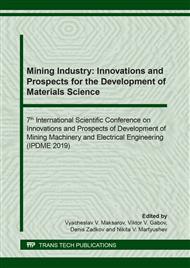[1]
A.G. Suslov, A.M. Dal'sky, Scientific foundations of engineering technology, Mashinostroenie Publ., Мoscow, 2002, 425 p.
Google Scholar
[2]
A.G. Suslov, E.D. Brown, N.A. Vitkevich et al., Machine quality: a guide. In 2 vols., vol. 1, Mashinostroenie Publ., Мoscow, 1995, 256 p.
Google Scholar
[3]
I.V. Kragelsky, Friction and wear, Mashinostroenie Publ., Moscow, 480 p.
Google Scholar
[4]
A.G. Suslov et al., 2008 Engineering surface parts. Coll., Mashinostroenie Publ., Moscow, 1968, 320 p.
Google Scholar
[5]
A.G. Suslov. The quality of the surface layer of machine parts, Mashinostroenie Publ., Moscow, 2000, 320 p.
Google Scholar
[6]
A.A. Alexandrov, Modern Technologies. System Analysis. Modeling 1(41) (2014) 140–145.
Google Scholar
[7]
I.V. Kragelsky, M.K. Dobychin, V.S. Kombalov, Basics of friction and wear, Mashinostroenie Publ., Мoscow, 1977, 540 p.
Google Scholar
[8]
A.G. Grigoryants, Fundamentals of laser processing of materials, Mashinostroenie Publ., Мoscow, 1989, 304 p.
Google Scholar
[9]
V.G. Kovalenko, A.D. Verkhoturov, L.F. Golovko et al., Laser and electroerosive hardening of materials, Nauka Publ., Moscow, 1986, 276 p.
Google Scholar
[10]
V.P. Morozov, Development of a method and technology for the restoration of aircraft parts and assemblies using laser surfacing, PhD dissertation thesis, Bauman MVTU, Moscow, 1987, 16 p.
Google Scholar
[11]
A.E. Balanovsky, V.V. Kondratev, V.O. Gorovoi, V.A. Ershov, A.I. Karlina, J. of physi.: conf. ser. (2018) 012004.
Google Scholar
[12]
A.G. Grigoryants, A.N. Safonov, Surface Laser Processing Methods: A textbook for universities, Vysshaya shkola Publ., Moscow, 1978, 191 p.
Google Scholar
[13]
A.G. Grigoryants, I.N. Shiganov, A.I. Misyurov, Technological procedures of laser processing: a textbook for universities, Bauman MSTU, Moscow, 2006, 644 p.
Google Scholar
[14]
A.E. Balanovsky, M.G. Shtayger, V.V. Kondratev et al., IOP Conf. Ser. Mater. Sci. and Engin. 411 (2018) 012013.
Google Scholar
[15]
A.E. Balanovsky, M.G. Shtaiger, V.V. Kondratev et al., J. of phys.: conf. ser. (2018) 012006.
Google Scholar
[16]
N.K. Tolochko, Physics and Chemistry of Materials Processing 1 (1995) 94–98.
Google Scholar
[17]
V.I. Shastin, S.K. Kargapol'tsev, I.S. Sitov, J. of Advanced Res. in Techn. Sci. 1 (2016) 96, North Charleston, USA: SRC MS, CreateSpace.
Google Scholar
[18]
S.V. Kostromin, Mater. of the int. conf. Research-to-Practice Conference": a collection of sci. papers "SWorld,, vol 1, no. 6, p.37–40, (2013).
Google Scholar
[19]
V.E. Borozinets, S.V. Kostromin, Modern innovations in science and technology, Mater. of the 3rd Int. sci. and pract. conf., p.28–31, 2013 (Kursk).
Google Scholar
[20]
V.I. Shastin, S.K. Kargapol'tsev, V.E. Gozbenko et al., Physical and Mechanical Properties of Engineering Materials Using Innovative Methods, Int. J. of Applied Engin. Res. 12 24 (2017) 15269-15272.
Google Scholar
[21]
I.A. Pinakhin, Volumetric pulsed laser hardening of cutting tools, Hard alloys. LAP LAMBERT Academic Publishing GmbH Co. KG, SKFU, Stavropol, 2014, 160 p.
Google Scholar
[22]
A.E. Balanovsky, V.V. Kondratev, M.G. Shtayger et al., IOP Conf. Ser. Mater. Sci. and Engin. 411 (2018) 012014.
Google Scholar
[23]
A.E. Balanovsky, M.G. Shtaiger, M.V. Grechneva et al., IOP Conf. Ser. Mater. Sci. and Engin. 411 (2018) 012012.
Google Scholar
[24]
V.Yu. Konyuhov, A.M. Gladkih, A.V. Chemezov, IOP Conf. Ser. Mater. Sci. and Engin. (2019) 012147.
Google Scholar
[25]
K.N. Vdovin, N.V. Koptseva, D.S. Gorlenko et al., Steel in Translation 49(4) (2019) 281-285.
Google Scholar
[26]
S.I. Shakhov, K.N. Vdovin, Steel in Translation 49(4) (2019) 261–264.
Google Scholar
[27]
N.N. Ivanchik, A.E. Balanovsky, M.G. Shtayger, I.A. Sysoev, A.I. Karlina, IOP Conf. Ser. Mater. Sci. and Engin. 411 (2018) 012035.
DOI: 10.1088/1757-899x/411/1/012035
Google Scholar
[28]
A.S. Kilov et al., Bulletin of the Orenburg State University 5 (2011) 164–170.
Google Scholar


